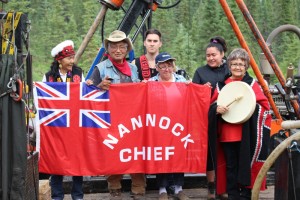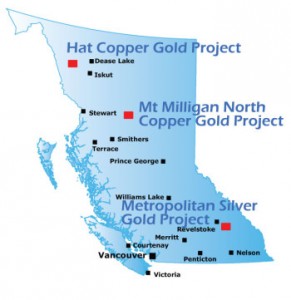
Developers of a mine on a Taku River tributary have stopped work after an on-site protest by a British Columbia tribal government. The Taku enters the ocean near Juneau.
The Hat gold and copper mining prospect is near the Sheslay River, a little more than 100 miles east of Alaska’s capital city. The Sheslay feeds into the Taku, a salmon-rich river used by commercial, sports and subsistence fishermen on the Alaska side of the border.
Vancouver-based Doubleview Capital Corp. has conducted exploratory drilling at the site for about two years. This summer, it ran into opposition.
“It’s just a very important place to our people,” says Chad Day, president of the Tahltan Central Council, which represents about 1,800 people in or from northwest British Columbia.
He says Tahltans have lived in the Sheslay area and some are buried there. He says it’s also an important place for hunting and fishing.
“That’s why we’re taking the position that we won’t be supporting any kind of exploration or mining activities in that area now or into the future,” he says.
Day and a group of Tahltan elders visited Doubleview’s Hat prospect drilling site earlier this summer. They spoke to workers, including tribal members, as well as company officials, about their objections.
“Thereafter the president and CEO made a commitment that the Tahltan workers would pack up and leave and that the camp would be demobilized and that he would aim to work with us more moving forward,” he says.
Doubleview officials did not immediately respond to interview requests. But a company press release acknowledges the meeting, as well as the shutdown, which it calls temporary.

In the release CEO Farshad Shirvani says, quote, “Our aim is to resume drilling as quickly as possible. … We are consulting with our legal counsel to determine the best steps to take to allow drilling to resume.”
Plans for the mine, plus at least two others in the Sheslay area, have caught the attention of critics downstream.
“The mines themselves create the usual worries of acid-mine drainage into a major and very productive Taku tributary,” says Chris Zimmer of Rivers Without Borders.
He says that could damage the river’s fisheries, especially sockeye salmon, which spawn and hatch in the area. He also points to plans to reopen an old access road.
“It’s this issue of the road becoming a can-opener for the region and leading to very, aggressive fast-paced development in an area that’s very critical for salmon habitat and First Nations traditional hunting and fishing as well,” Zimmer says.
The Tahltans are not the only tribal group with claims to the area. The Taku River Tlingit First Nation has an extensive land-use plan negotiated with the provincial government that includes the Sheslay river and valley.
That plan shows at least part of the area open to some development. Taku Tlingit leaders could not be immediately reached for comment.
The British Columbia’s Ministry of Mines issued Doubleview an exploration permit about three years ago. The agency says that came after consulting with the Tahltan and Taku First Nations.
Tahltan Central Council President Chad Day says that’s not the case.
He says Tahltan leaders are not opposed to all resource development. They negotiated an agreement this year with Imperial Metals’ Red Chris Mine, in the Stikine River watershed.
“It’s a controversial project for some people. But at the end of the day, we put all the terms past the Tahltan Nation and 87 percent of the nation supported the Red Chris co-management agreement,” Day says.
The mine began full production recently. Day says Tahltans are working at the mine site.
Imperial Metals also owns the Mount Polley Mine in central British Columbia, where a tailings dam collapsed last August. That sent billions of gallons of water and silt into nearby waterways. The Red Chris dam follows a similar design, though there are differences.
Ed Schoenfeld is Regional News Director for CoastAlaska, a consortium of public radio stations in Ketchikan, Juneau, Sitka, Petersburg and Wrangell.
He primarily covers Southeast Alaska regional topics, including the state ferry system, transboundary mining, the Tongass National Forest and Native corporations and issues.
He has also worked as a manager, editor and reporter for the Juneau Empire newspaper and Juneau public radio station KTOO. He’s also reported for commercial station KINY in Juneau and public stations KPFA in Berkley, WYSO in Yellow Springs, Ohio, and WUHY in Philadelphia. He’s lived in Alaska since 1979 and is a contributor to Alaska Public Radio Network newscasts, the Northwest (Public Radio) News Network and National Native News. He is a board member of the Alaska Press Club. Originally from Cleveland, Ohio, he lives in Douglas.




